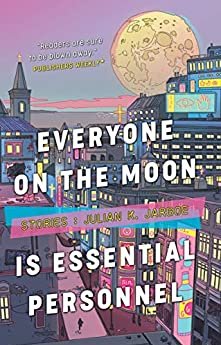
I reviewed Julian K. Jarboe's debut story collection Everyone on the Moon is Essential Personnel for The Seattle Review of Books (Lethe Press, March 2020). Here's how the review begins:
Scissors dropping out of a uterus, a head attached to its neck with just a green ribbon, cement poured down throats to keep the soul from escaping — these are but a few examples of what I think about when I think about body-horror, a genre in which the graphic metamorphosis or destruction of a body creates a viscerally disturbing experience for the reader. Myth and fairy tale, in their rawest iterations, are natural precedents for body-horror. And isn’t the body itself, so much a source for horror? On its own the body can mutate; or outside forces, like, oh, say, a deadly pandemic exacerbated by capitalism and climate change, can impose new, terrifying ways of trying to stay alive.
